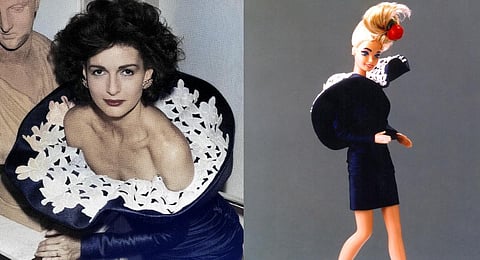

The Barbie has been part of households since the ’60s. Its maker, businessman Ellliot Handler, a co-founder of the Mattel toy company, was persuaded to create it by his wife, Ruth, who watched their daughter play with paper dolls but found that she was assigning them adult roles. From a striped swimsuit with a high ponytail, its first look, to Japanese home-makers stitching her first clothes, the brand has had many spin artists and embroiderers trying their hand in giving the doll their own signature. Lecoanet-Hemant, is perhaps the only Indo-French haute couture brand that can be credited in dressing up the doll, that thanks to the new Greta Gerwig-helmed Barbie movie is nothing short of a cultural phenomenon, bringing back into conversation a toy that has been integral to the world of fashion.
Barbie was a step towards adulthood, a way for young creative kids to dress like grown-ups, find joy in clothes, hair, accessories and the world of beauty. “I was deeply fond of Barbie growing up and in some way it ushered me into fully realising my love for clothes and how they truly stand for individuality and expression. So the child in me jumped at the opportunity to create haute couture looks for Barbie when Mattel reached out to us for collaborations in the ’80s”, notes co-founder Hemant Sagar, one half of the creative duo behind Lecoanet-Hemant.
The Eighties was the golden era of haute couture and Lecoanet Hemant was deftly leaving a signature impression on the Parisian fashion map. Sagar and Didier, created 33 haute couture collections in Paris starting 1981 till Spring/Summer 2000. Their aesthetics drew comment, controversy, but their design signatures of elevated collars and chiffon gowns, to the painting techniques such as glazing and tempera—wowed fashion watchers.
Their first collaboration was in 1989 and saw Barbie in a fabulous sculptural dress reminiscent of the ’80s over-the-top couture fantasies. Mattel came calling in 1995—this time for their personal collection. They wanted a crinoline gown from ‘Libertine,’ a haute couture collection of Lecoanet-Hemant underlining the free spirit lavishness of the 18th century French bourgeois.
Even if it was for a doll, the fashion house the commission very seriously and haute couture techniques crafted with the same textiles used in haute couture dresses were used with painstaking processes. “The seamstress with the finest fingers in the atelier initiated the construction and it was no small feat,” adds Didier Lecoanet who designed these creations. Hemant, of Indo-German parentage, was also reminded of a childhood memory during this exercise. His German grandmother was an apprentice at a designer’s workshop, learning to make tiny silk chrysanthemums – cut on bias and hand stitched.
“Something about that memory resonated strongly with what we were doing for Barbie. It was a full circle moment,” he says. The year 1999 witnessed another Barbie X Lecoanet Hemant moment, but in an entirely new context. In a Sotheby's supported event, hosted by the Egyptian embassy in Paris, Lecoanet Hemant joined hands with heritage Japanese jewellers Mikimoto for a custom Barbie ensemble—draped in silk gazar and the finest fur, complimented by the rarest pearls. It was a fashion dream come true and remains of the most beloved projects helmed by the house, say the designers. In 2000, Lecoanet Hemant left Paris and established themselves in New Delhi where a new chapter in their story began. But they haven’t forgotten their tryst with Barbie.